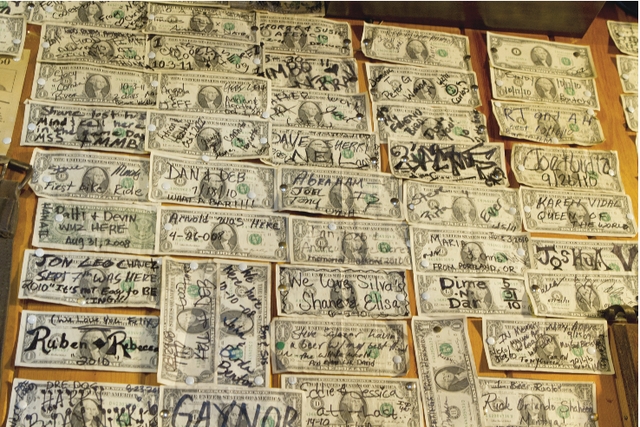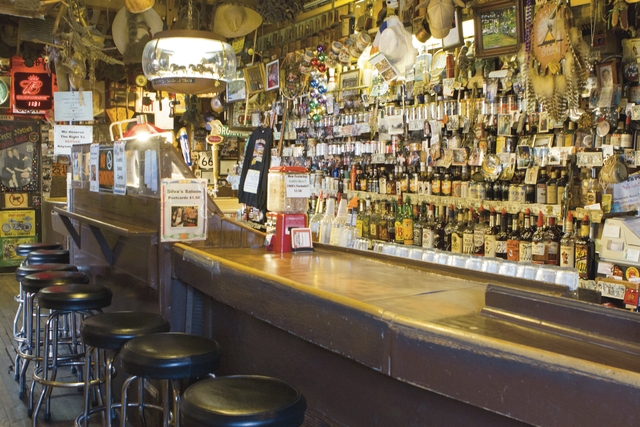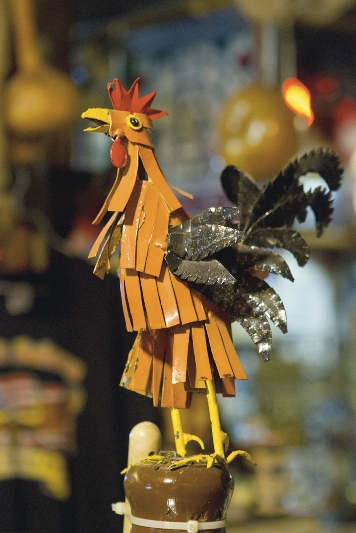Silva’s Saloon is the subject of town lore. More than a few Bernalillo old timers believe it has an underground tunnel that was used to transport illegal booze. (It doesn’t.) That proprietor Felix Silva Sr. kept nine loaded guns stashed throughout the building, just in case. (True.) That a CIA agent used the pay phone to call in to headquarters. (Also true.) A veritable wall of booze still stands in the middle of the room. Some of the liquor bottles are pushing a century old, and occasionally a lucky patron is treated to a taste of ancient spirits. Old brandy apparently tastes lovely. The Silvas have taken care to preserve the bottles in wax so the alcohol doesn’t evaporate as the corks shrink away.Felix Silva Jr. owns the saloon now. And while granddaughter Denise Silva tends bar, it isn’t her chosen career. She made her living as an elementary school teacher in Albuquerque and Rio Rancho. After retiring, she returned to the bar to help out. It did not come naturally. She keeps a rabbit-eared copy of Bartending for Dummies under the counter. The saloon is for sale—lock, stock and barrel. But Denise says she’s keeping the book, which helped her through several misadventures when she first found herself standing behind that burnished wood counter. She jokes that a customer once told her not to bother reaching for her book, that a Screwdriver is just vodka and orange juice.“Daddy’s getting older, and I’m no spring chicken. I’m also not a night person,” Denise says. She doesn’t seem to take after her grandfather in that respect. Felix Sr. opened the Bernalillo saloon that bears his family name in 1933, one day after Prohibition ended. It was far from his first day in the liquor business. Here in New Mexico, statewide Prohibition was approved in 1917—three years before the national ban on booze began. Sociologist David J. Hanson writes that it was popular at first, with supporters outnumbering opponents three to one. Within a year after the ban, nearly a dozen bootleggers were operating in Santa Fe alone. By the time it ended 16 years later, Hanson says 80 percent of New Mexicans were opposed to it. While the country experimented with teetotalism, the Bernalillo businessman was making corn liquor, his stills hidden in apple orchards. He bottled his moonshine, stowed it in a truck with a false bottom in the bed and stacked some hay bales on top. Then he’d haul it off to Oklahoma, which didn’t repeal Prohibition until 1959. He dodged “federales” while he moved his product to market. Denise says Felix Sr. ran Silva’s Saloon until his death in 1995. He always wore an apron and opened up at 7 a.m., closing at 2 a.m. In the ’30s and ’40s, illegal card games were not uncommon in the back room. “They would have those poker games running three days straight,” Denise says. “My dad would be cleaning out spittoons and outhouses. Back when they still had outhouses.” The building also used to come out 17 feet farther. Silva’s had to be cut down when the road was paved. The place has been here so long, people used to show up in horse-drawn wagons. Back when you could bring a child into a bar, Felix Sr. always had a bag of chips and a soda waiting. Come in today and you’ll see a broken piano dating to the 19 th century sitting in a corner next to high-backed booths. Dusty windows are aflame with sunlight during the day. The pool table closes at 8 p.m. to help head off trouble. Street peddlers pop in and out selling jewelry. On any given afternoon, a few patrons sit and sip beers, their bikes parked out front.“What I’m going to miss when we sell the place—the customers,” Denise says. “I’ve met a lot of neat people and I’ve made a lot of friends.” Regulars sit on the right side of the wraparound bar. It’s a neighborhood joint, a “Cheers” bar, to have Denise say it. Leon Padilla has been coming to Silva’s for about eight years and has never seen any problems. He says he comes in a few times a week. This afternoon, he’s sitting in his usual spot sipping a tonic water and lime. “There’s no riffraff in here,” Padilla says. “There’s nobody that ever comes in here looking for trouble.” Denise says if the place has a rough reputation, it’s undeserved. A sign on the front door announces a ban on wearing motorcycle club colors inside. That keeps a lot of rabble-rousers away. “They say we aren’t being fair,” she says of some motorcycle club members. “They won’t come in.”Just down the road is Camino Real Antiques, which also served as a watering hole in years past. Elvis stopped in once. Blood stains still mar the hardwood floors from some long-forgotten bar fight.There may be antiques, but no decorator has ever put his or her stamp on Silva’s. The best way to describe the look of the place is “organic.” There are license plates, hats, photos of celebrities, memorials to regulars who have shuffled off this mortal coil, an old pack of Chesterfields, a pair of rubber S & M boots, alcohol advertisements, sports regalia, a wooden hand giving a disembodied finger. A Green Bay Packers “cheese-head” evidences the Vikings/Packers rivalry that exists among a few patrons. People write messages on dollar bills that Felix Jr. affixes to any available spot on the wall. And then, of course, there are the velvet paintings of voluptuous naked women. Denise says they come from formerly single married patrons who couldn’t bear to completely part with them.You can understand why movie and television crews have used this place as a backdrop over the decades. The romantic comedy Animal Behavior starring Karen Allen and Armand Assante was filmed primarily at the University of New Mexico, but a scene was shot at Silva’s. Denise says Julia Roberts served as Allen’s understudy, and an aged photo of a very young Roberts is tacked to the wall. An episode of the old detective show “Mannix” was filmed here as well. The Silvas would welcome more film crews—just as long as they don’t disturb the decor. Actors not working on movies stop in, too. Danny Trejo (“Machete”), who has relatives in Bernalillo, is one of them. He showed off his Charo tattoo to patrons lucky enough to be there that day. Customers remember a soft-spokeness that belied his rough exterior. The saloon is also a destination for Route 66 pilgrims. “People come back to see the things on the walls, following Route 66,” Denise explains. Silva’s is listed in at least one book on the subject, which partly explains why it’s had patrons from almost every state and nearly 40 countries. Icelanders, Scots, Englishmen—you name it, they’ve probably come in.Italians who live 10 minutes apart in Italy have stopped by 10 minutes apart at Silva’s, then left for Acoma, never knowing that their countrymen lagged just a few minutes behind. Japanese businessmen took group shots behind the bar, the rustic saloon embodying the very essence of the “Wild West.” They later thanked the Silvas for the photo op by sending them a pair of toenail clippers bearing the image of a geisha girl. Another tchotchke for the wall.Even though the Silvas are trying to sell the joint, they say they want someone who’ll keep the memorabilia—and the spirit—intact.“We are looking for a buyer,” Denise explains, “who appreciates the museum quality.”
Silva's Saloon955 Camino del Pueblo, BernalilloHours: 11 a.m. to 8 p.m.-ish, Monday through Saturday; noon to 6 p.m.-ish Sunday“We’re open,” says Denise, “but she’s for sale!” Call the saloon at 867-9976 with inquiries.














